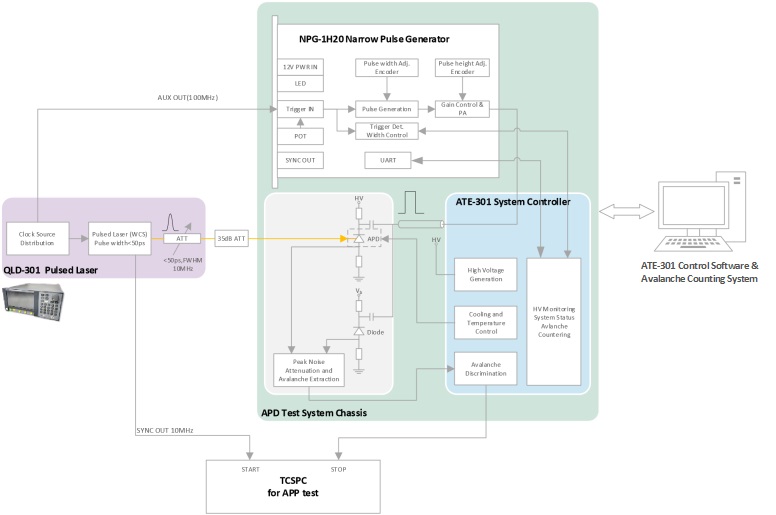|
适用于封装的 SPAD(APD) TO46 或 TO8 的 TCSPC 测试解决方案
封装SPAD测试系统由皮秒脉冲激光器QLD-301,闸门控制生成模块NPG-1H20,测试主控模块ATE-301和测试机箱(包括TO46水冷制冷单元)组成。此外,还需要一套TCSPC仪器。用于测试脉冲后及时间抖动。其中,QLD-301是内置信号源的皮秒脉冲激光器,可以生成具有可调延迟的电和光脉冲(目前为独立仪器,后期可以升级为机箱板卡的模块);
NPG-1H20可以生成具有可调振幅和脉宽的闸门脉冲信号;ATE-301部分包含APD相关模式块(高压产生,制冷和温度控制,双通道鉴别计数器);测试箱包括TO46制冷和信号提取单元,机箱背板等,其中TO46制冷和信号提取单元包括:水冷散热器,保温结构,TEC制冷单元,尖噪声抑制和信号提取电路,TO-46夹具和信号接口等。系统组成和原理-框图如下图所示:

图1 SPAD测试平台的系统组成和原理图
QLD-301皮秒脉冲激光器包括:
● 信号生成器模块(时钟源分布):它可以接收外部参考时钟或使用内部时钟源来生成一个同步的激光脉冲触发时钟和APD门控时钟,可调的相对延迟。通常,APD门控时钟的频率是激光触发时钟的整数倍,系统提供了2倍、5倍、10倍、20倍、50倍和100倍的选项;
● 皮秒脉冲激光器(Pulsed Laser):它能够生成与触发时钟同频率的同步激光脉冲,脉宽小于50ps,消光比大于40dB。此外,由它生成的激光同步时钟用作计数模块的输入信号;
● 光功率监测和衰减控制模块(ATT):控制激光脉冲的衰减,将其衰减到单光子的水平,并通过高灵敏度的光功率监测确保脉冲功率的稳定性。
NPG-1H20门控生成模块主要包括:
● 触发输入和监控单元,触发频率覆盖0.1~100MHz,兼容任何电平的触发输入;
● 门控幅度可调,调整范围覆盖4~6.4V,优于100mV/步,编码器调整;
● 门宽度可调,调整范围覆盖0.5~2ns,10ps/步,编码器调整。
ATE-301测试主控模块主要包括:
● SPAD相关模块:包括高压生成,冷却和温度控制等模块;系统基于门控熄灭方法使SPAD工作在门控模式下,在此模式下,测试SPAD的检测效率,归一化暗计数率和后脉冲概率;
● 双通道计数器模块(双通道计数器):用于计数雪崩计数值,并且以后可以升级为一个符合计数模块,通过与激光同步时钟自动找到峰值并计数符合函数以自动测量后脉冲概率。

图2 方案组成示意图
TO-46测试夹具主要包含:
● 水冷TEC制冷和保温结构:使用工业级三级制冷片,结合水冷散热技术,可以在室温20°C时实现≤-60°C的温度控制,满足SPAD的低温需求;最大限度地减少热辐射和热对流。
● SPAD夹具和模拟前端:采用独特的纯铜导热夹具和高速平衡差分技术,支持TO-46封装的SPAD(最大外径6mm,封装结构见附录1),且结构易于更换;对尖峰噪声有高度抑制,可以有效提取SPAD的雪崩信号;
● 信号接口:包括光猪尾线出口,射频同轴和DB9接口,分别用于传输单光子信号,门控输入信号,雪崩输出信号和系统主机的高压和温度控制接口。
性能
具体性能及指标参数如下表所示
|